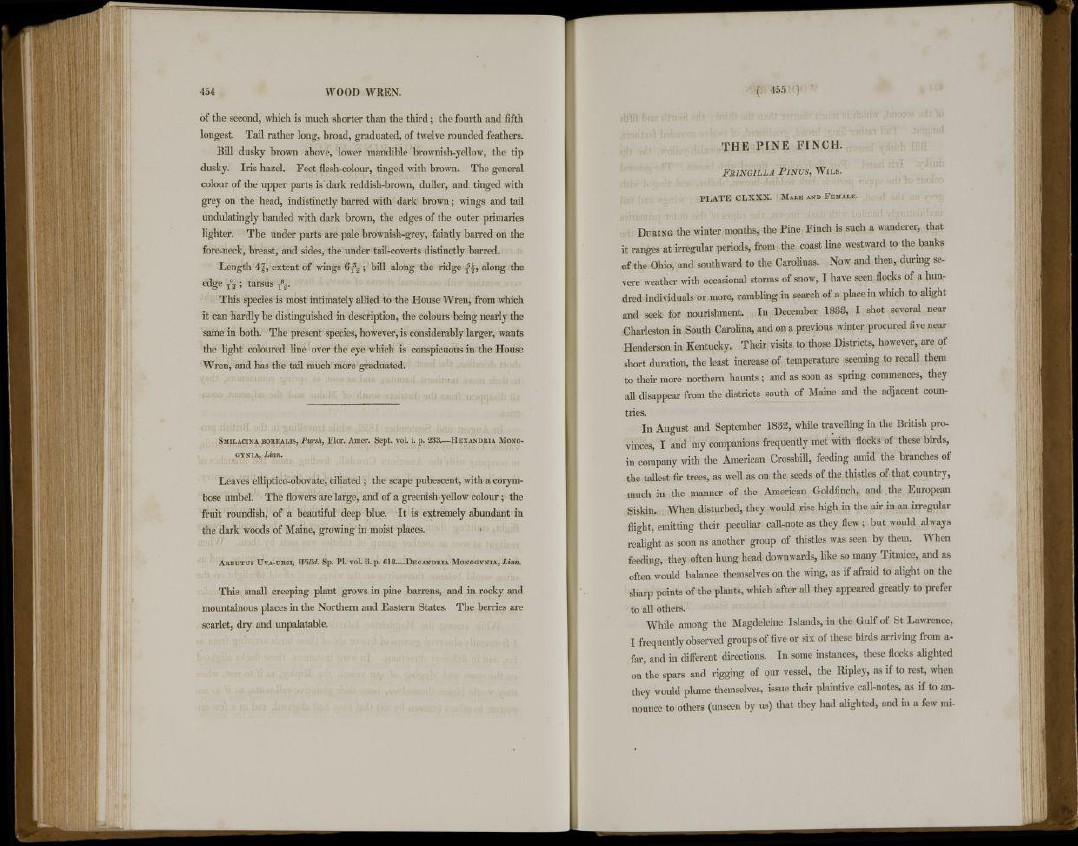
454 W O O D W R E N .
of the second, which is much shorter than the third; the fourth and fifth
longest. Tail rather long, broad, graduated, of twelve rounded feathers.
Bill dusky brown above, lower mandible brownish-yellow, the tip
dusky. Iris hazel. Feet flesh-colour, tinged with brown. The general
colour of the upper parts is dark reddish-brown, duller, and tinged with
grey on the head, indistinctly barred with dark brown; wings and tail
undulatingly banded with dark brown, the edges of the outer primaries
lighter. The under parts are pale brownish-grey, faintly barred on the
fore-neck, breast, and sides, the under tail-coverts distinctly barred.
Length 4 | , extent of wings 6T
3
2 ; bill along the ridge along the
edge ft ; tarsus T
8
2 .
This species is most intimately allied to the House Wren, from which
it can hardly be distinguished in description, the colours being nearly the
same in both. The present species, however, is considerably larger, wants
the light coloured line over the eye which is conspicuous in the House
Wren, and has the tail much more graduated.
SMILACINA BOREALIS, Pursh, Flor. Amer. Sept. vol. i. p. 233.—HEXANDRIA MONOGYNIA,
Linn.
Leaves elliptico-obovate, ciliated ; the scape pubescent, with a corymbose
umbel. The flowers are large, and of a greenish-yellow colour ; the
fruit roundish, of a beautiful deep blue. It is extremely abundant in
the dark woods of Maine, growing in moist places.
ARBUTUS UVA-TJRSI, Willd. Sp. PI. vol. ii. p. 618.—DECANDRIA MONOGYNIA, Linn.
This small creeping plant grows in pine barrens, and in rocky and
mountainous places in the Northern and Eastern States. The berries are
scarlet, dry and unpalatable.
( 455 )
THE P I N E FINCH.
FRINGILLA PINUS, WILS.
PLATE CLXXX. MALE AND FEMALE.
DURING the winter months, the Pine Finch is such a wanderer, that
it ranges at irregular periods, from the coast line westward to the banks
of the Ohio, and southward to the Carolinas. Now and then, during severe
weather with occasional storms of snow, I have seen flocks of a hundred
individuals or more, rambling in search of a place in which to alight
and seek for nourishment. In December 1833, I shot several near
Charleston in South Carolina, and on a previous winter procured five near
Henderson in Kentucky. Their visits to those Districts, however, are of
short duration, the least increase of temperature seeming to recall them
to their more northern haunts; and as soon as spring commences, they
all disappear from the districts south of Maine and the adjacent countries.
In August and September 1832, while travelling in the British provinces,
I and my companions frequently met with flocks of these birds,
in company with the American Crossbill, feeding amid the branches of
the tallest fir trees, as well as on the seeds of the thistles of that country,
much in the manner of the American Goldfinch, and the European
Siskin. When disturbed, they would rise high in the air in an irregular
flight, emitting their peculiar call-note as they flew; but would always
realight as soon as another group of thistles was seen by them. When
feeding, they often hung head downwards, like so many Titmice, and as
often would balance themselves on the wing, as if afraid to alight on the
sharp points of the plants, which after all they appeared greatly to prefer
to all others.
While among the Magdeleine Islands, in the Gulf of St Lawrence,
I frequently observed groups of five or six of these birds arriving from afar,
and in different directions. In some instances, these flocks alighted
on the spars and rigging of our vessel, the Ripley, as if to rest, when
they would plume themselves, issue their plaintive call-notes, as if to announce
to others (unseen by us) that they had alighted, and in a few mi